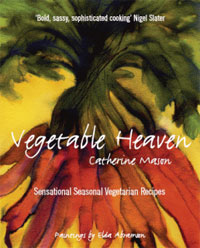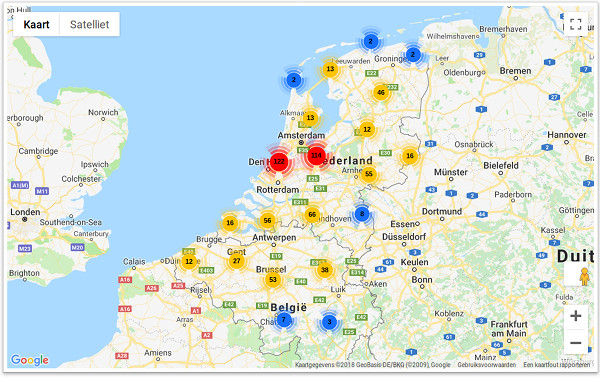 In haar prachtig geïllustreerde kookboek Vegetable heaven: sensational seasonal vegetarian recipes geeft Catherine Mason hemelse recepten voor seizoensgroenten.
In haar prachtig geïllustreerde kookboek Vegetable heaven: sensational seasonal vegetarian recipes geeft Catherine Mason hemelse recepten voor seizoensgroenten.  Seizoensgroenten, bestaan die nog wel? Veel seizoensgroenten zijn tegenwoordig vrijwel het hele jaar in de supermarkt te verkrijgen. Catherine Mason, de auteur van Vegetable heaven is zelf wel afhankelijk van de seizoenen omdat ze haar groenten zelf kweekt of ze biologisch koopt. Dit boek is bedoeld voor koks die zich ook door de seizoenen (willen) laten leiden.
Seizoensgroenten, bestaan die nog wel? Veel seizoensgroenten zijn tegenwoordig vrijwel het hele jaar in de supermarkt te verkrijgen. Catherine Mason, de auteur van Vegetable heaven is zelf wel afhankelijk van de seizoenen omdat ze haar groenten zelf kweekt of ze biologisch koopt. Dit boek is bedoeld voor koks die zich ook door de seizoenen (willen) laten leiden.
Hoewel de seizoenen als uitgangspunt wordt gebruikt, zijn de recpeten helaas niet geordend op seizoen, maar per gang. In de recepten zelf staat vaak wel vermeld op welk seizoen het van toepassing is.
In Starters, Soups and Salads, geeft Mason tien recepten voor verschillende weertypes. Voor de zomer raadt Mason bijvoorbeeld haar vrij eenvoudige recept Green bean, olive and lemon salad aan dat met brood en geitenkaas een heerlijke zomerse lunchmaaltijd is (zie recept onderaan).
De Main Courses zijn onderverdeeld in type gerechten: Tarts and pies, Stove-top vegetables, Gratins, Fritatas, Grains, Stuffed, baked and roasted vegetables, Pasta and gnocchi. Elke categorie bevat gemiddeld zes recepten, waaronder verassende combinaties als Spinach and pumpkin gnocchi en Green risotto with fresh peas and mint cream. De recepten die worden gegeven als Companion Dishes bevat merkwaardig veel aardappelrecepten, die gelukkig wel heel divers zijn: van gebakken aardappels tot aardappelcake.
In de hoofdstukken Desserts en Baking staan heerlijke recepten voor brood, gebak, ijs en fruitdesserts. Mason geeft ook nog enkele ontbijtrecepten waarbij het ook niet aan originaliteit ontbreekt. Two Fig Clafouti, de titel van het recept doet Mason denken aan een karakter uit oude John Wayne films, is een combinatie van warme vijgen, yoghurt en eieren. Tot slot geeft Mason nog enkele recepten voor basissauzen en dressings als Blue cheese dressing en Walnutsauce.
Vegetable heaven is een erg omvangrijk boek dat, ondanks de bijzondere recepten en ongebruikelijke combinaties, ook geschikt lijkt voor de beginnende kok. Mason beschrijft haar recepten zorgvuldig in stappenplannen, die door haar man zijn getest op werkbaarheid. Ook de gevorderde kok kan met deze recepten uit de voeten, want Mason vermeldt bij veel recepten variatietips. De gebruikte ingrediënten in de recepten zijn goed verkrijgbaar bij supermarkt, natuurwinkel of (bio)markt.
Het boek ziet er prachtig uit door illustraties van Elda Abramson. Toen het kookboek in de maak was, heeft Mason een poll gehouden onder vrienden over het nut van foto's in kookboeken. Het resultaat was dat de helft van haar vrienden fotografie in kookboeken als nuttig ervaart en de andere helft als intimiderend. Om de laatste groep niet af te schrikken heeft ze besloten geen foto's van gerechten te gebruiken, maar een kunstenaar haar kookboek laten illustreren met platen van groenten. De kleurrijken platen zijn overigens na te bestellen: leuk voor in de keuken!
Het zorgvuldig en grappig geschreven boek is een aanrader voor koks die de Engelse taal slechts als kleine hindernis zien tot een schat aan originele recepten.
Green bean, olive and lemon salad
This is a very tasty way of serving choice young beans fresh from the garden in summer. The Moroccan preserved lemons definitely add a certain something, but don't you worry if you don't have any - simply substitute a chunk of unpeeled, well-scrubbed, fresh organic lemon and a little extra salt. Served with some fresh Somerset goat's cheese and decent bread this salad makes a lovely, simple warm-weather lunch.
- 450 g small runner or French beans, trimmed
- 1 tablespoon finely-chopped red onion
- 8 Kalamata olives, stoned and cut into rings
- 1/8 preserved lemon, finely chopped
- 1 clove of garlic, peeled and crushed
- 3 tablespoons of olive oil
- freshly-squeezed lemon juize, to taste (about 1/3 of a lemon's worth)
- salt and pepper
1. Cook the beans in plenty of boiling salted water until just tender (3-5 minutes). Meanwhile put the onion, olives, preserved lemon, garlic and olive oil into the salad bowl and mix together.
2. As soon as the beans are cooked, drain and add them to the salad bowl, swirling them aroud so they are well-coated with the dressing ingredients. Add the lemon juice, salt and pepper to your liking, tasting as you go. Serve while still slightly warm.
Serves 3-4
Moroccan preserved lemons
Preserved lemons can be used to add their distinctive flavour to many different savoury dishes, but be warned - they are very addictive. For a while I was adding them to just about everything I cooked. Generally, you chop a chunk or two very finely and add it to whatever you're cooking near the start of the cooking time. It is something recommended that you scrape off and discard the flesh, using only the rind, but I have not found this to be necessary - I use the whole lot, and often inlcude some of the preserving liquid for good measure. When you've finished the lemons, the lemony oil makes a fantastic cooking medium too.
- 4 or 5 ripe lemons
- 75 g coarse sea salt
- olive oil
1. Scrub and dry two of the lemons and cut them into chunks. I usually cut them into eights, as this gives pieces of a useful size. Pack the chunks into a glass jar to which there is a non-reactive lid (i.e. one made from glass, cork, plastic or plastic-coated metal).
2. Squeeze the juice from the remaining lemons until you have 100 ml. Add the salt and lemon juice to the jar and keep it at room temperature with the lid on for 7 days. Shake the jar once a day during this time.
3. The lemons are now ready for use and will keep for a long time if covered with olive oil and stored in the fridge.
Vegetable heaven: sensational seasonal vegetarian recipes (2006)
Catherine Mason
Paperback, 224 pagina's
ISBN: 1904943535
€ 25,85 




